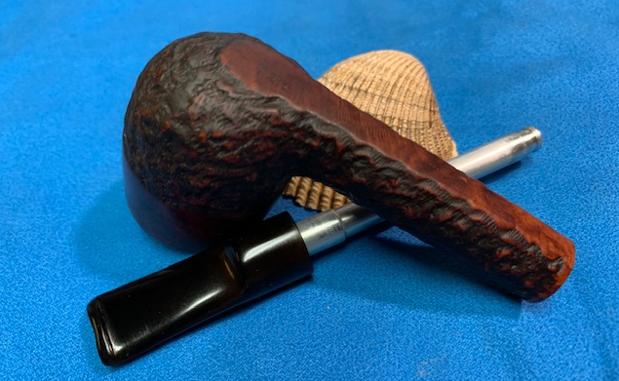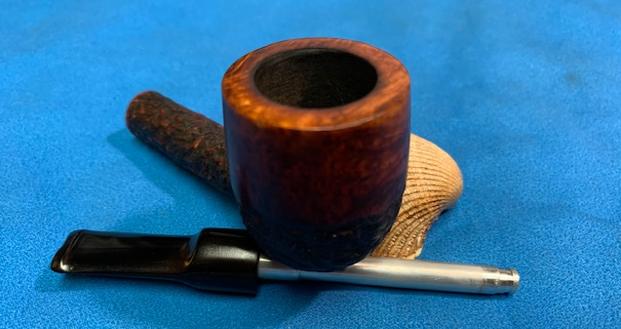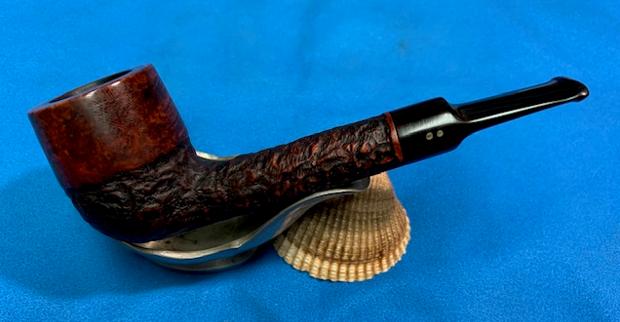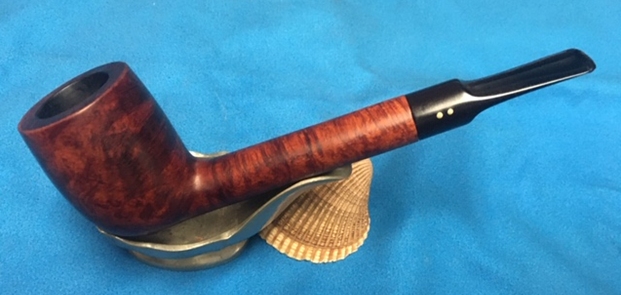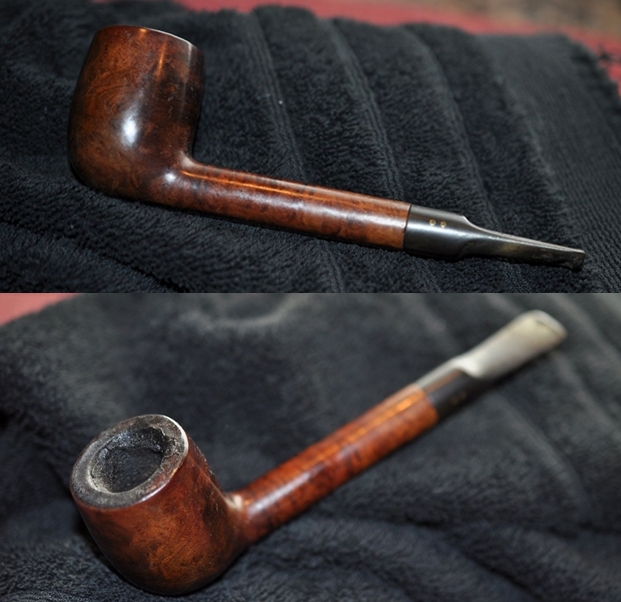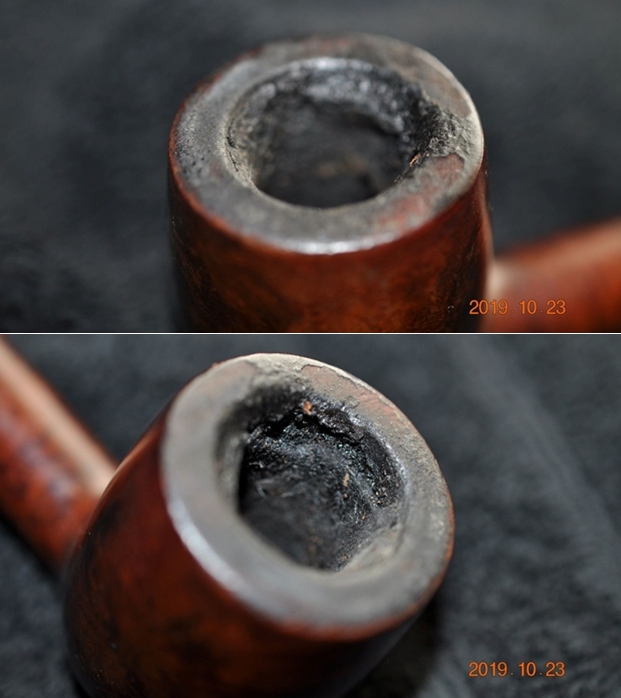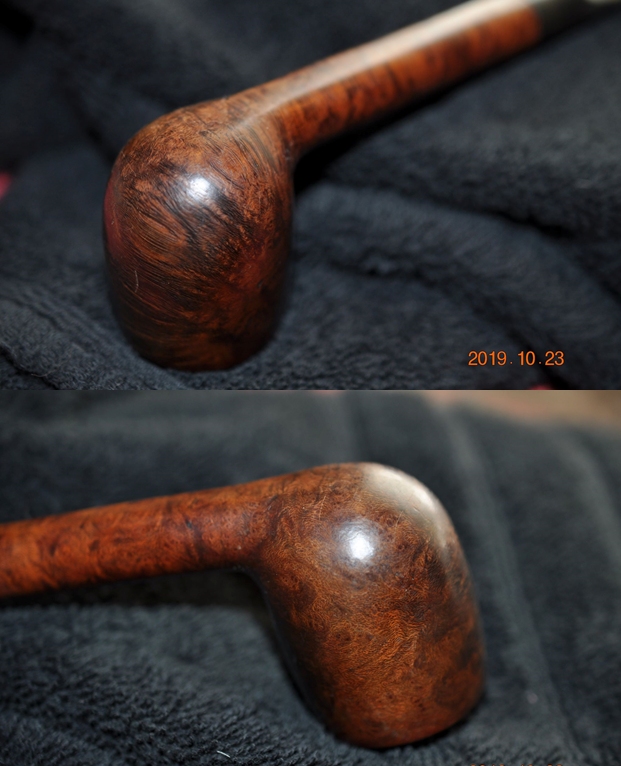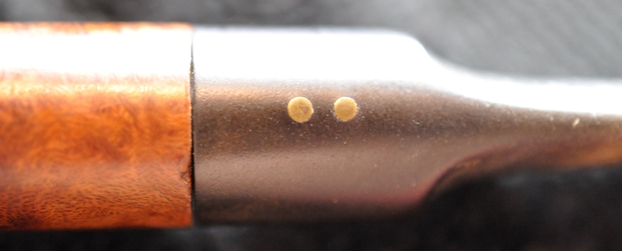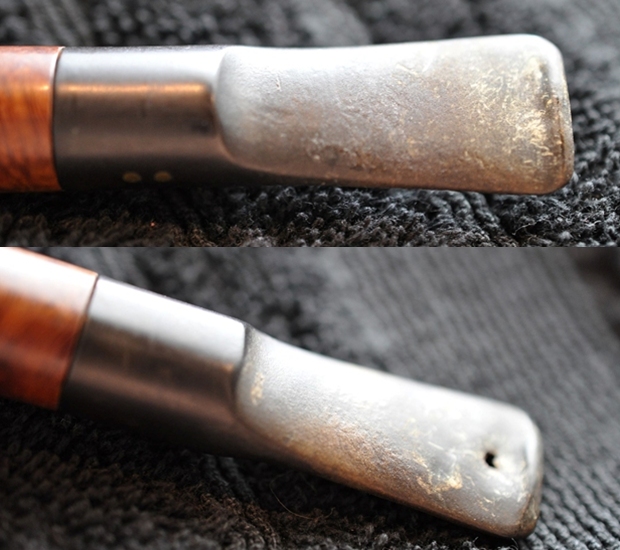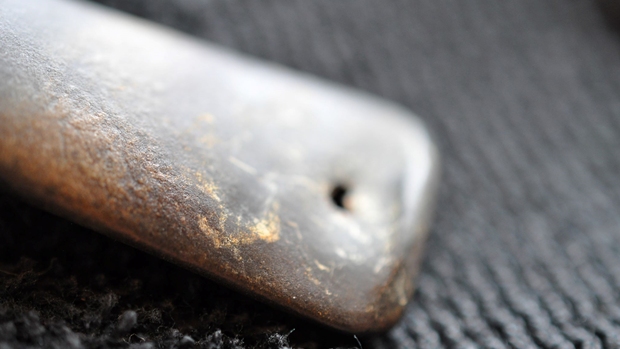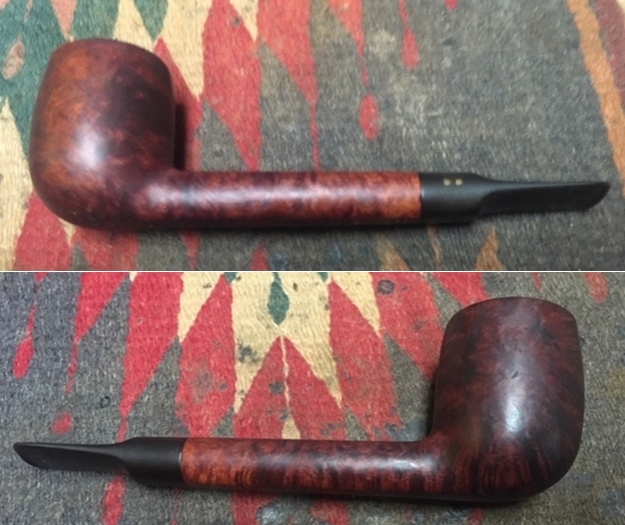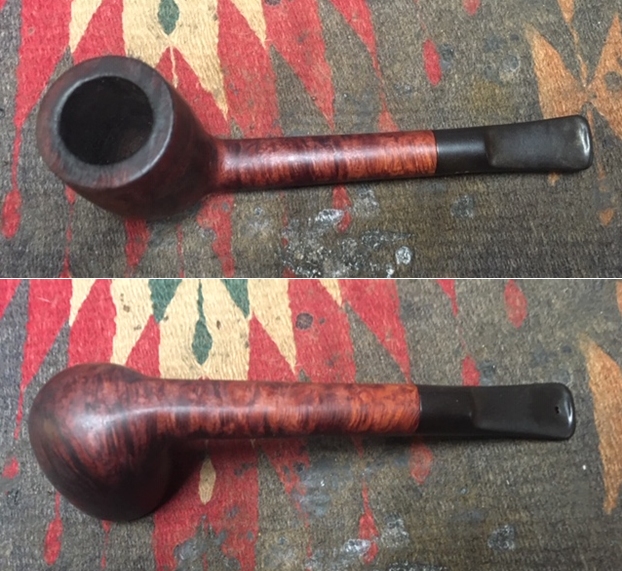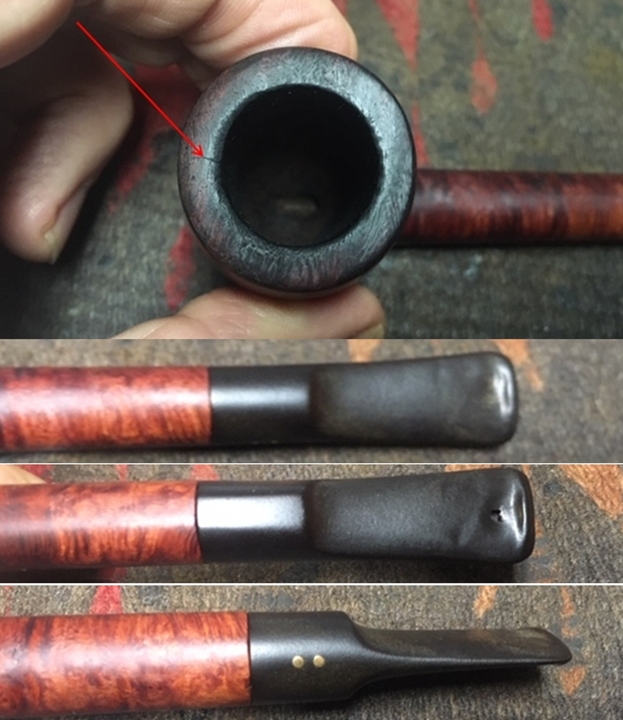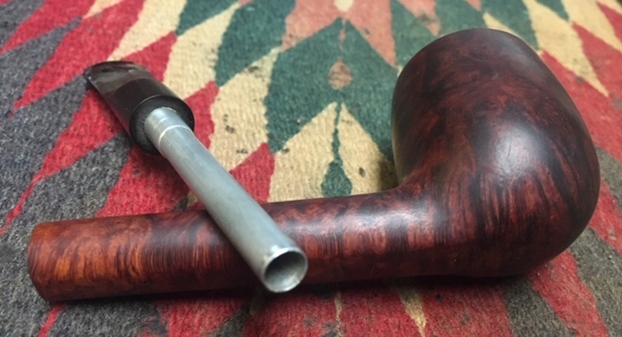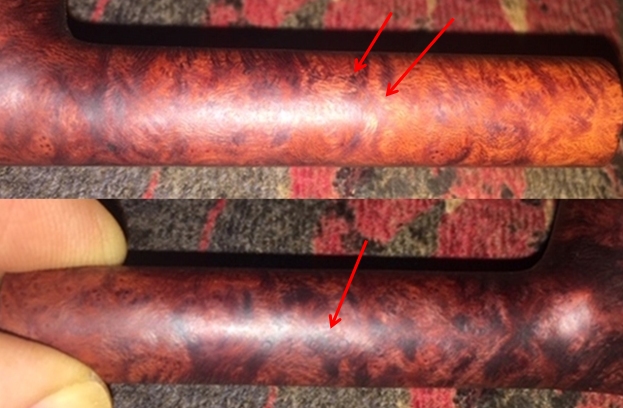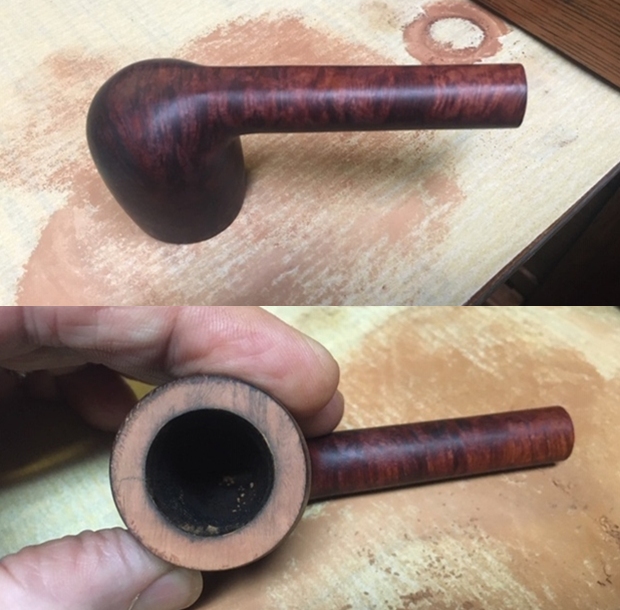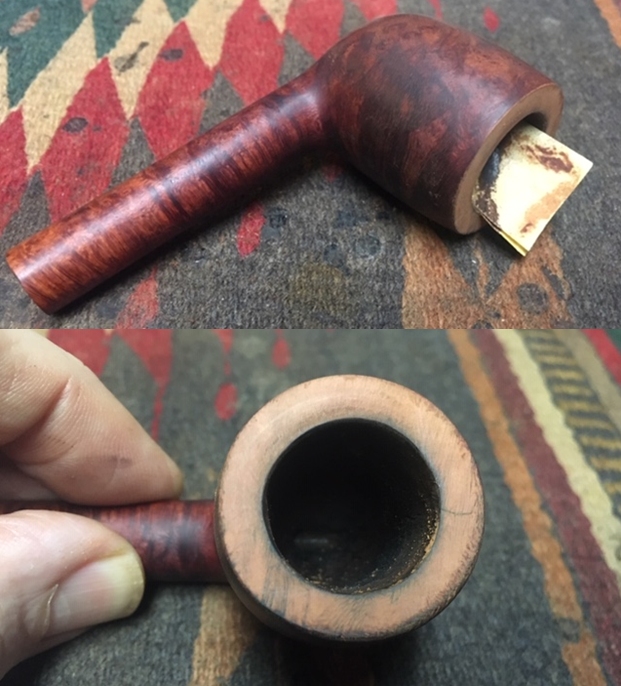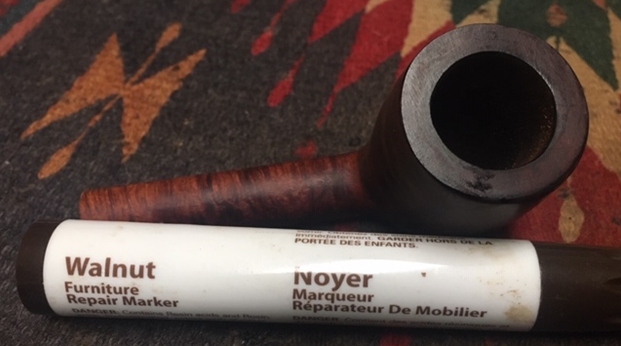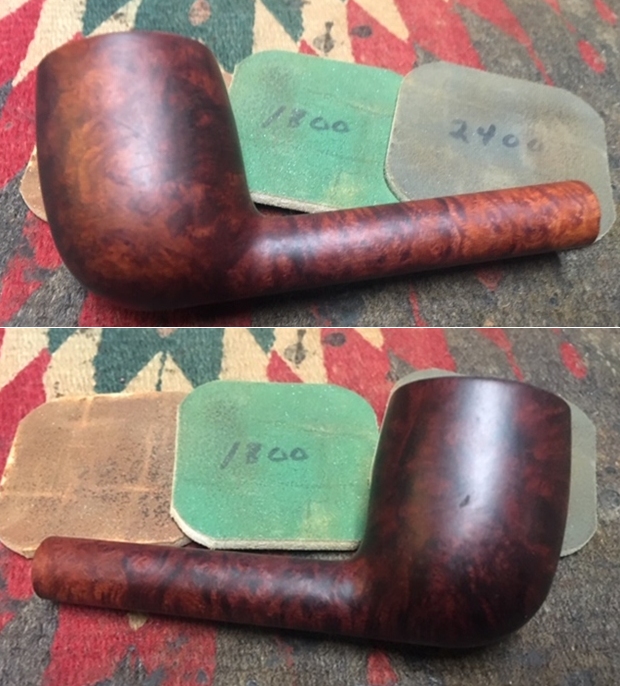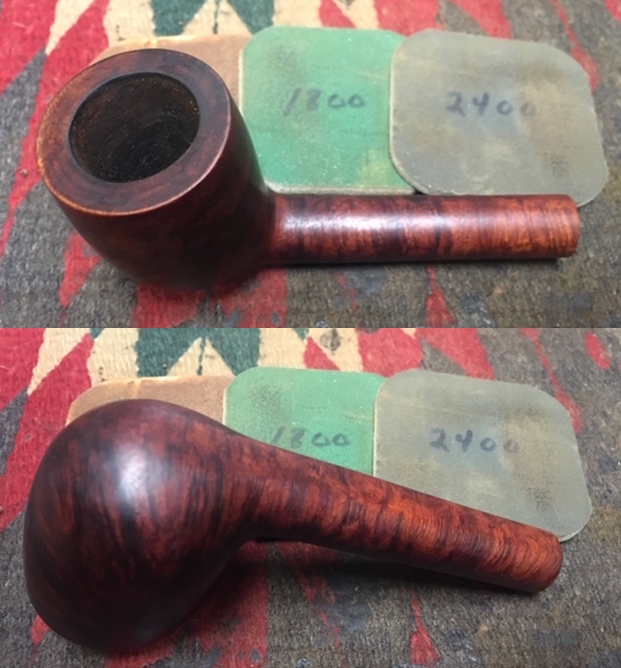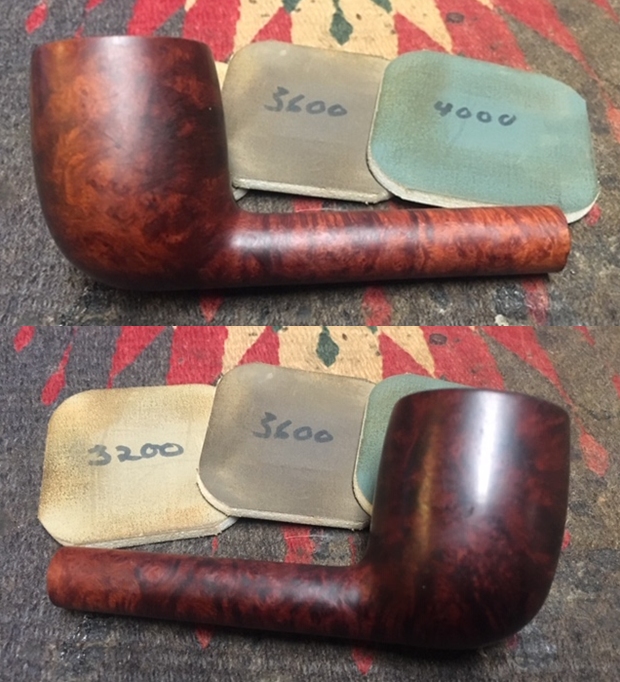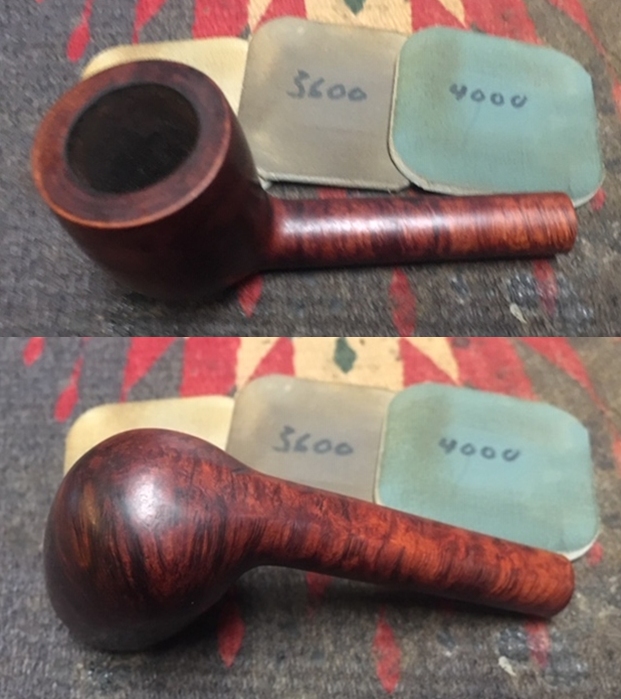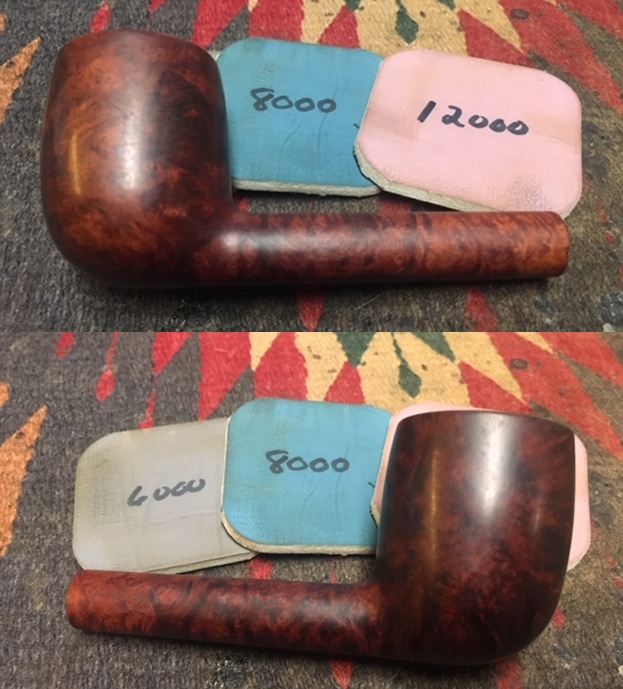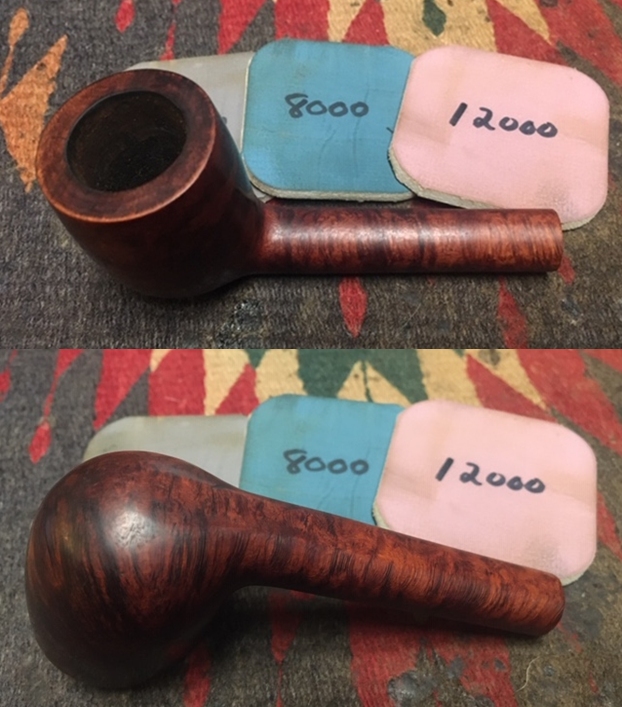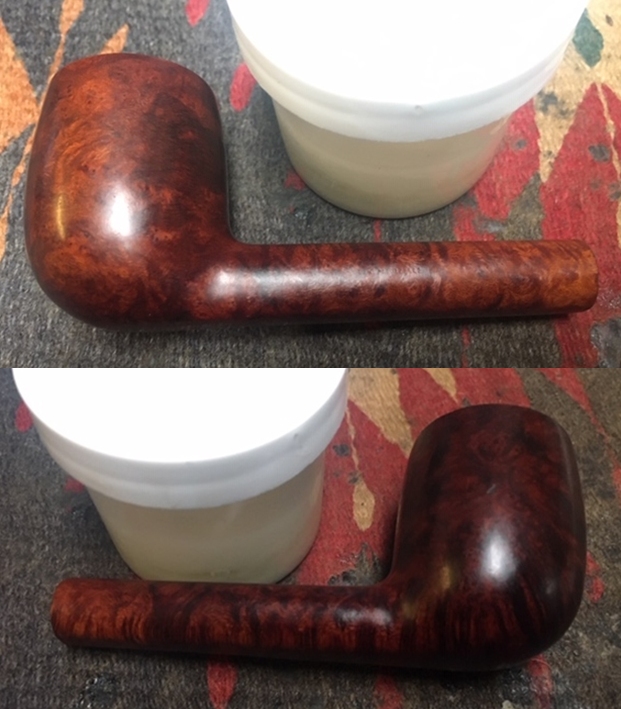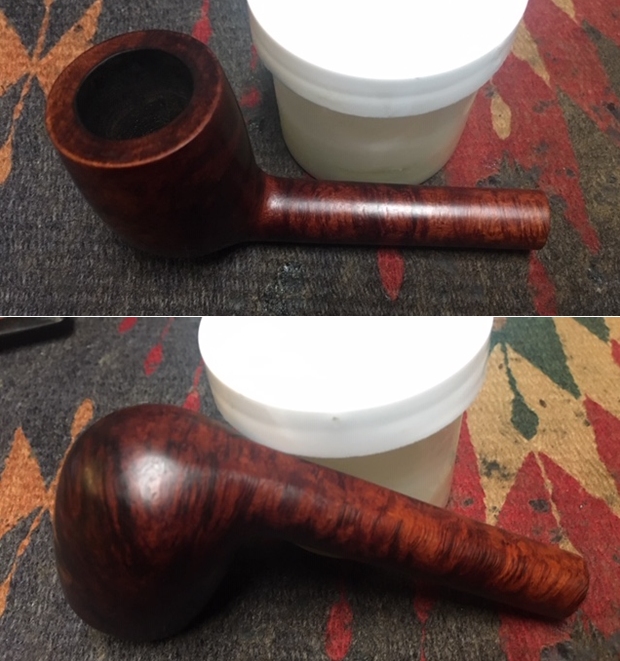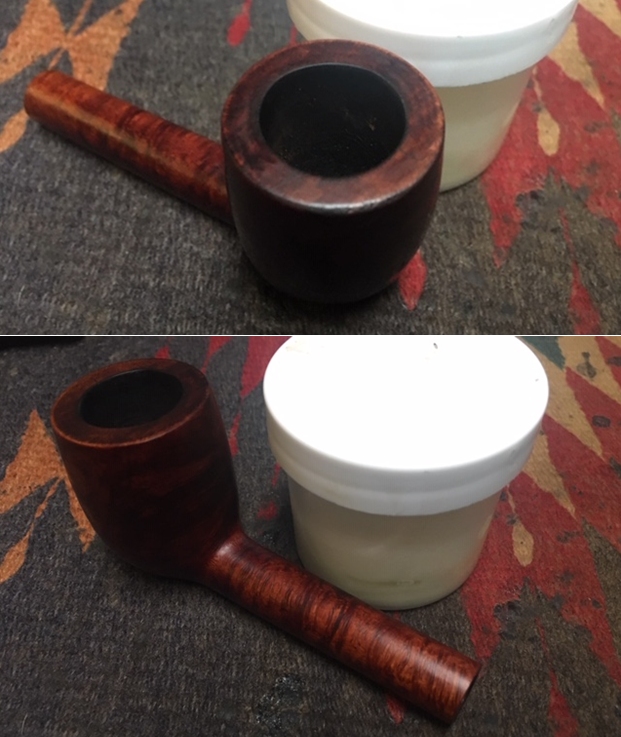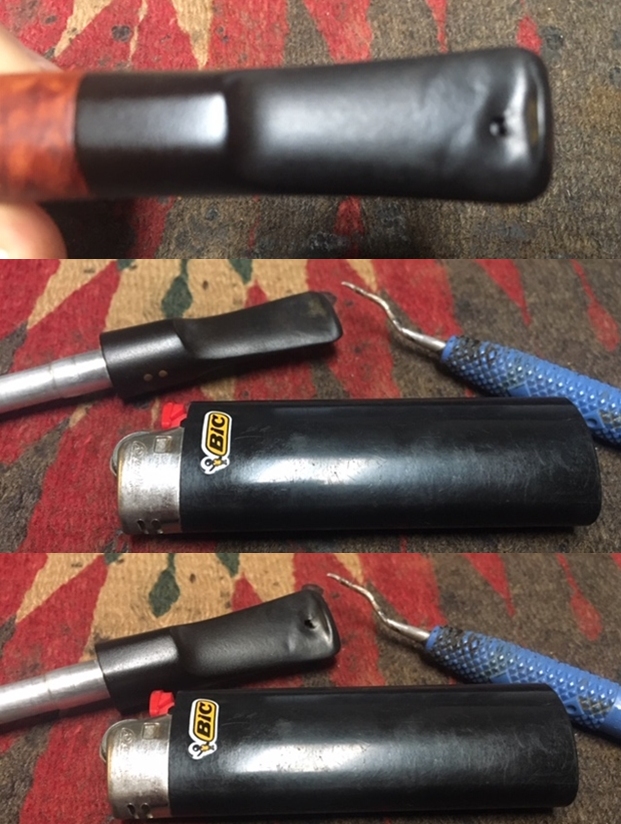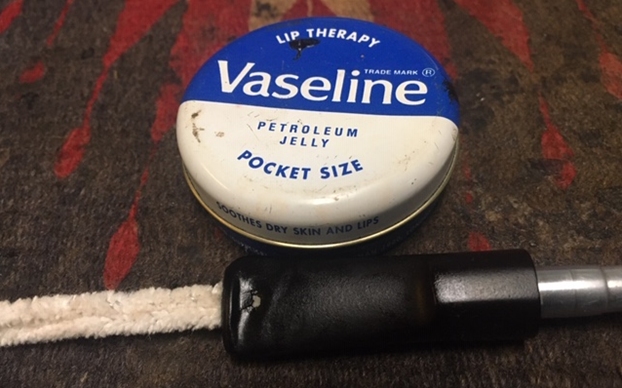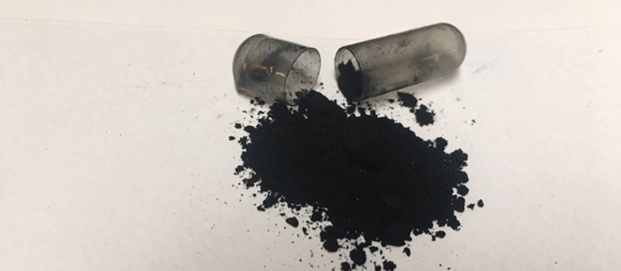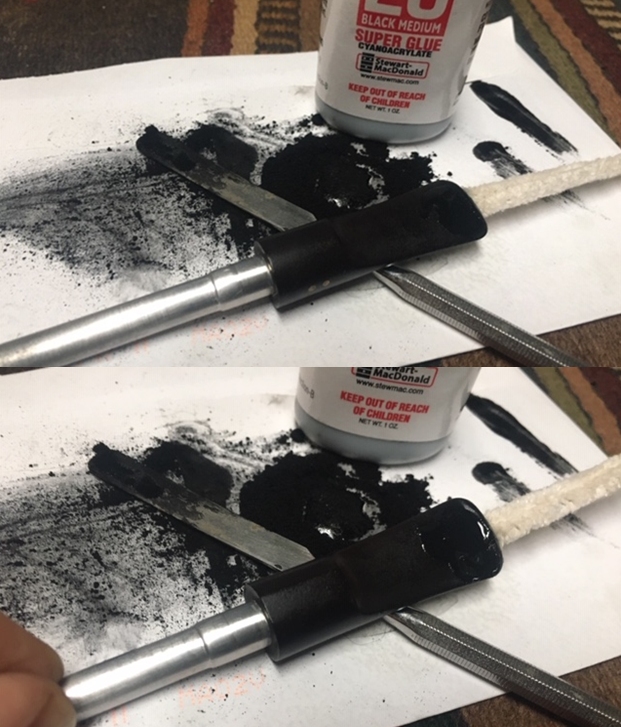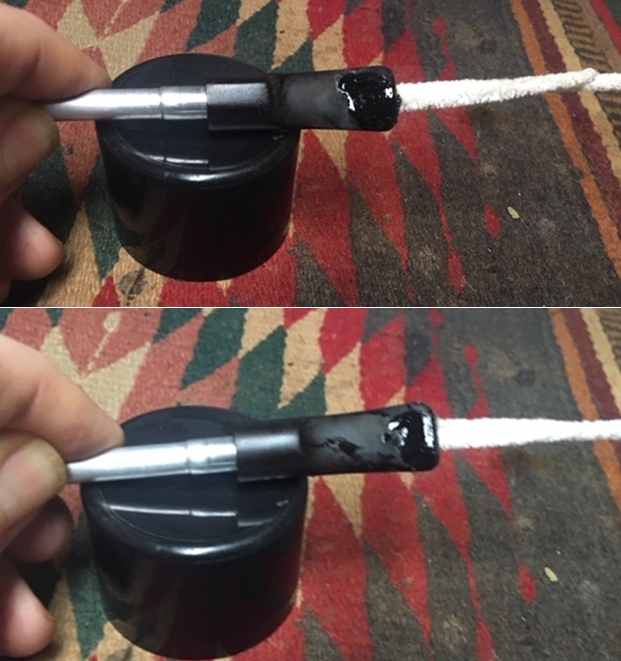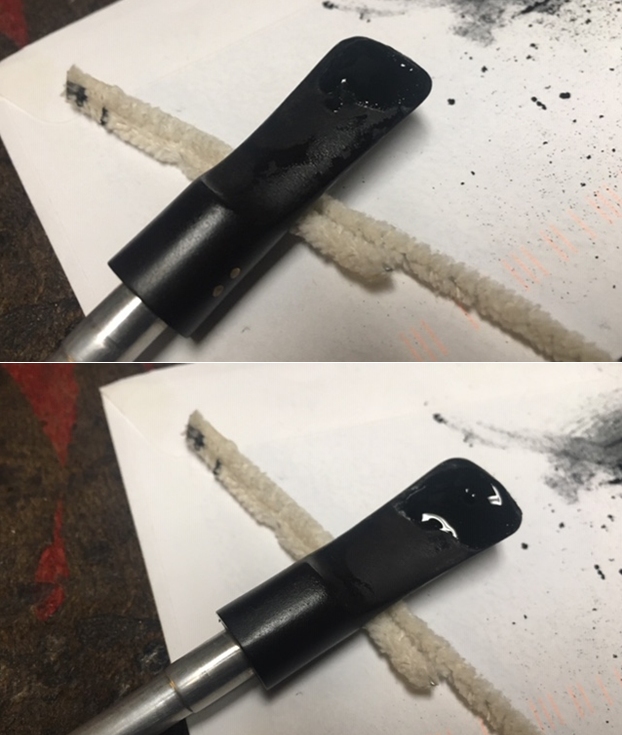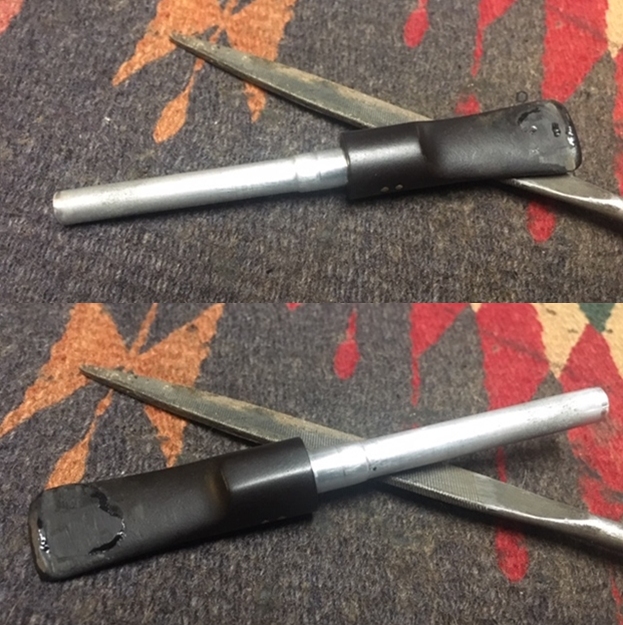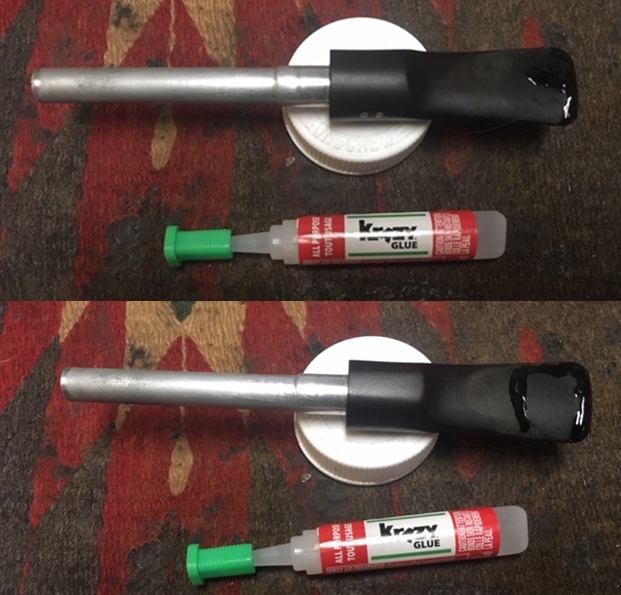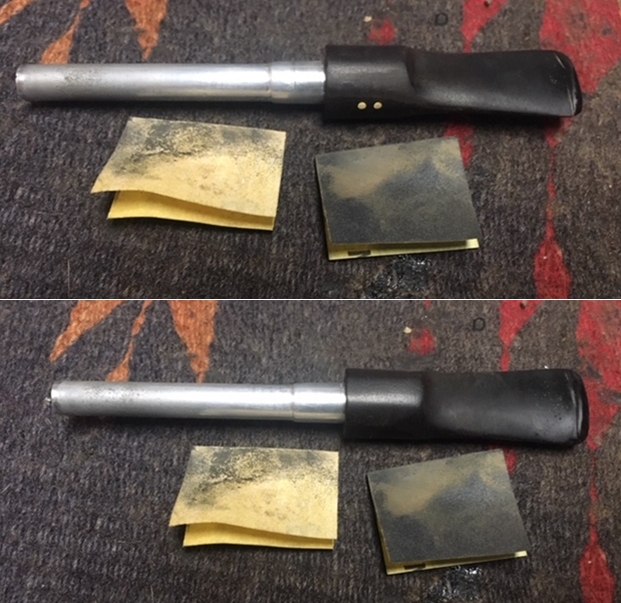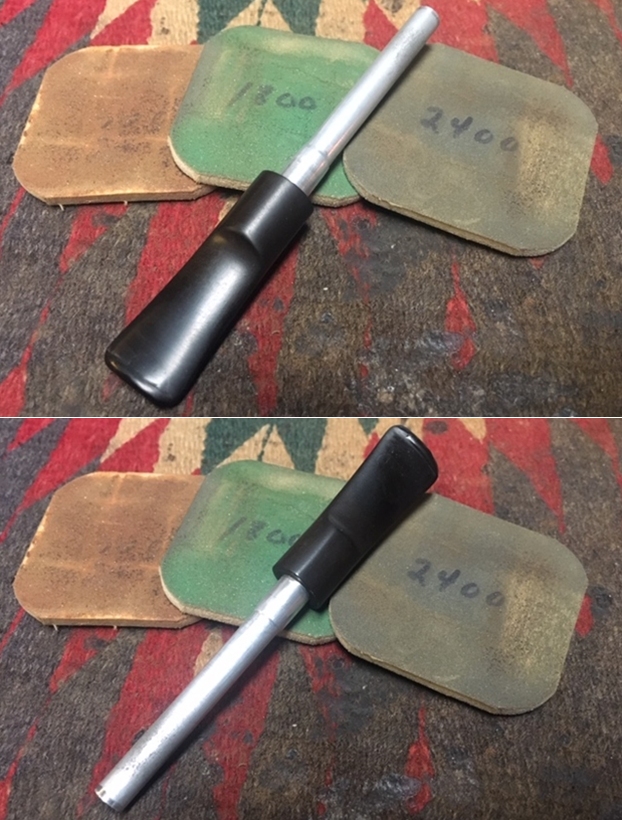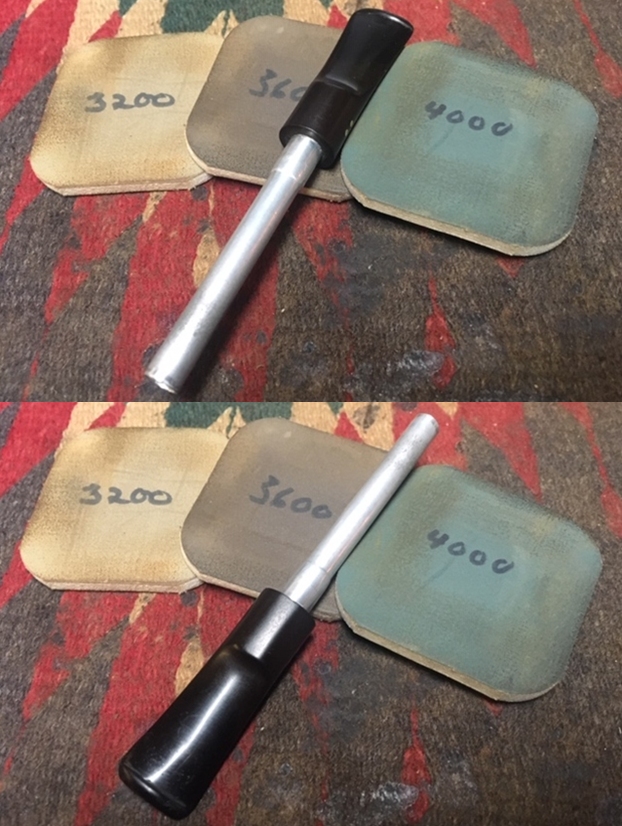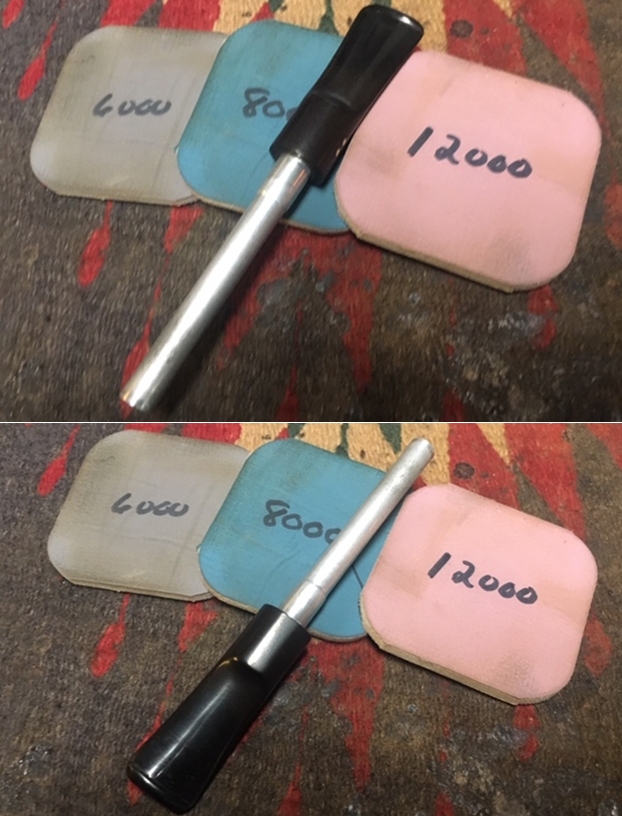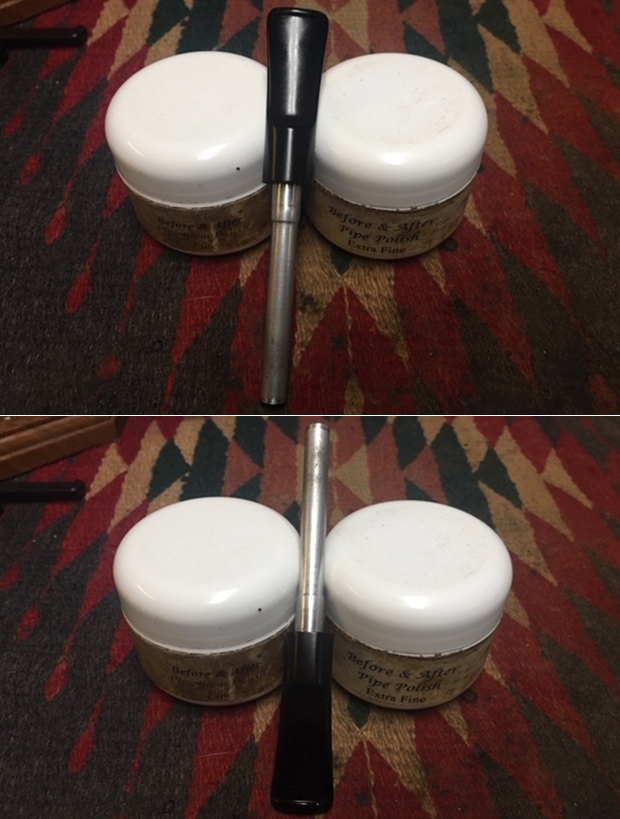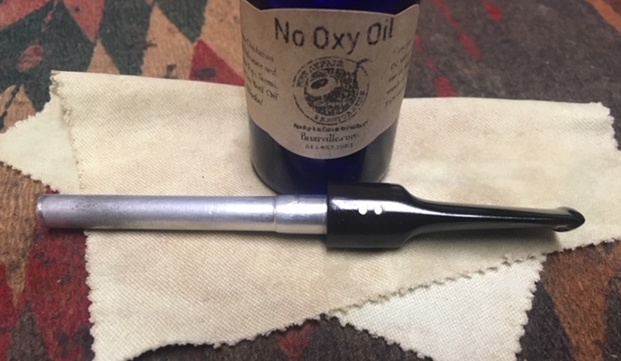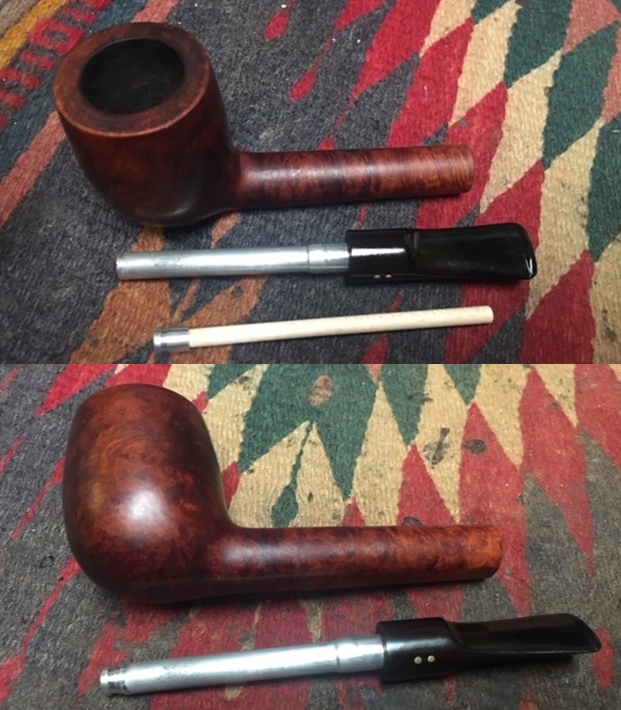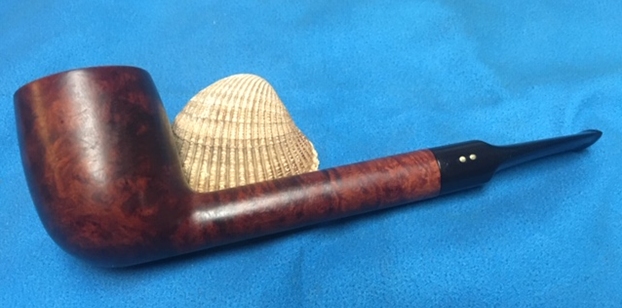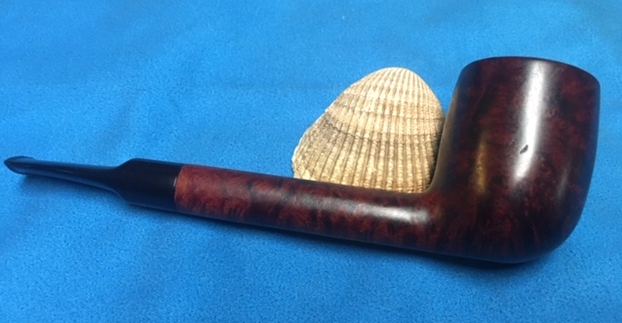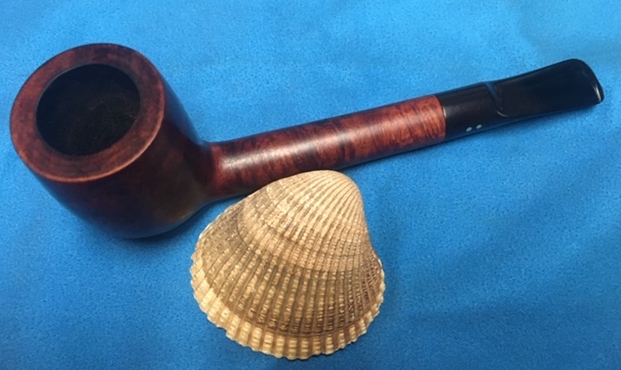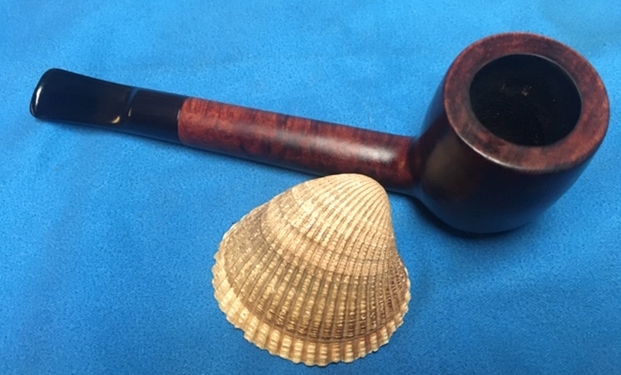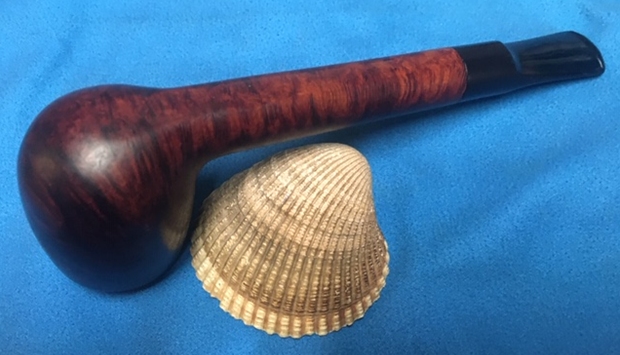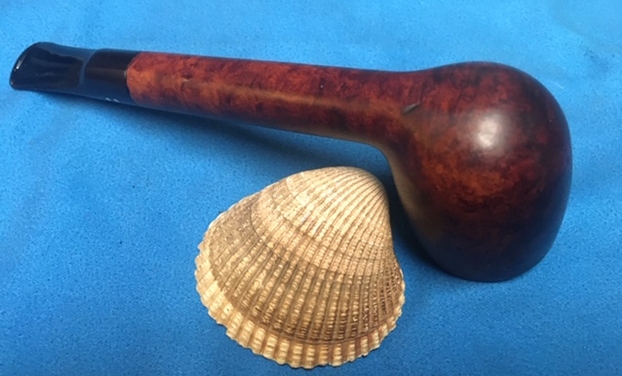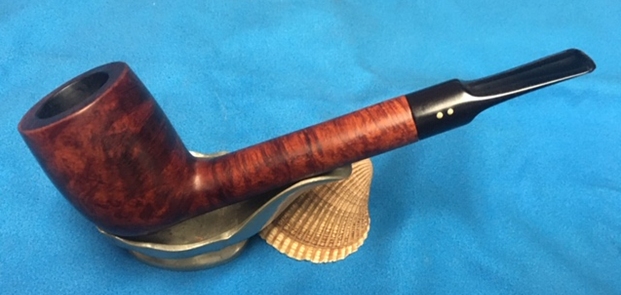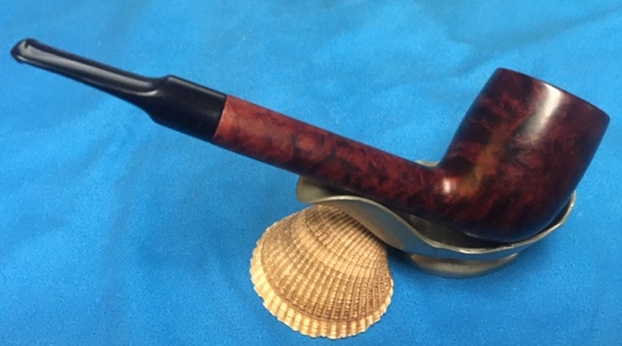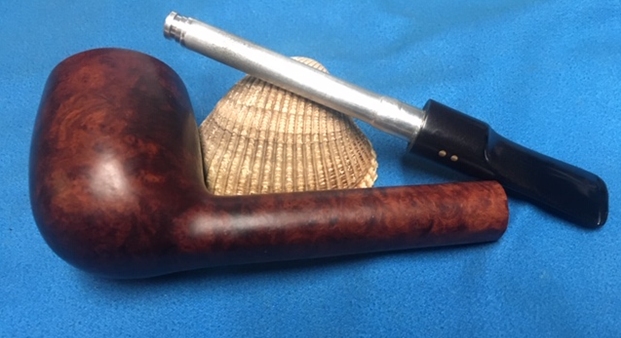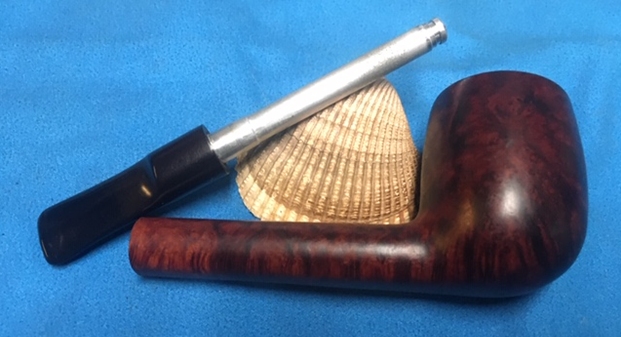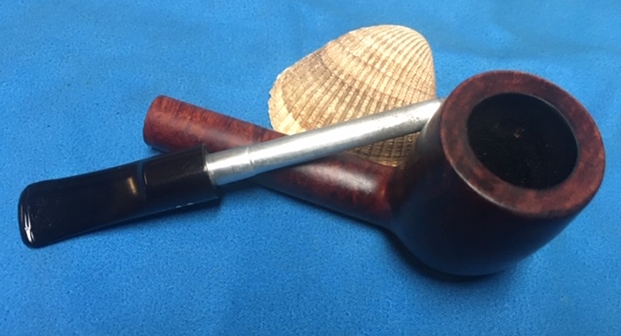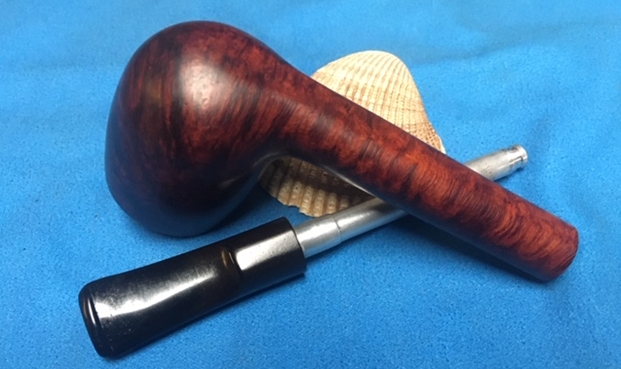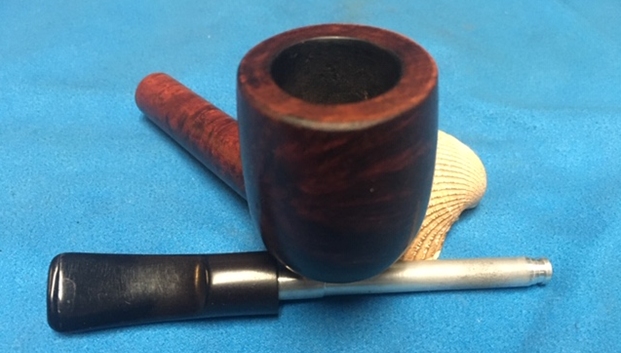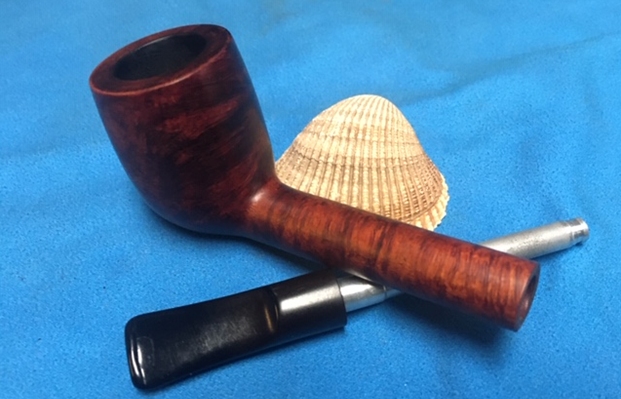Blog by Steve Laug
I have been working on Peterson’s pipes from my friend’s estate for the last little while and I needed a break from them for a while. I chose to work a Canadian Made Brigham Mixed Grain Lovat for a change of pace. The Lovat was stamped on the underside of the shank with faint stamping visible with a lens under light. It reads Can. Pat. 372982 followed by Brigham underlined and in script. On the heel of the bowl it was stamped with the shape number 299. There was a thick cake in the bowl with remnants of tobacco stuck on the walls. There was a lava overflow on the rim. The top and edges of the rim appear to have some damage. There is damage all the way around the outside edges of the bowl. The grain on the smooth portion of the bowl was a combination of grains. Once again, I think that there was a beautiful pipe underneath all of the buildup of years of use. The stem was oxidized and calcified toward the end with some tooth chatter. There were also some tooth marks on both sides of the stem ahead of the button and on the button surface itself. There was a pattern of two brass dots on the left side of the saddle stem. Jeff took photos of the pipe before he started his cleanup work on it.
 Jeff took photos of the bowl and rim top to show the thick, hard cake in the bowl with remnants of tobacco stuck on the walls of the bowl. There was a lava build up on the top of the rim and the edges of the bowl. The rim top had a lot of scratching and damage on the top and around the inner and outer edges. It looked like it had been used for a hammer. He took photos of the top and underside of the stem showing the tooth chatter, scratching and oxidation on the stem surface and wear on the edges of the button.
Jeff took photos of the bowl and rim top to show the thick, hard cake in the bowl with remnants of tobacco stuck on the walls of the bowl. There was a lava build up on the top of the rim and the edges of the bowl. The rim top had a lot of scratching and damage on the top and around the inner and outer edges. It looked like it had been used for a hammer. He took photos of the top and underside of the stem showing the tooth chatter, scratching and oxidation on the stem surface and wear on the edges of the button. 
 Jeff took a photo of the side and heel of the bowl to show the condition of the finish. You can see the beautiful grain around the smooth portions on the top half of the bowl. The rustication is well done and rugged. Even under the dirt and debris of the years it looked very good.
Jeff took a photo of the side and heel of the bowl to show the condition of the finish. You can see the beautiful grain around the smooth portions on the top half of the bowl. The rustication is well done and rugged. Even under the dirt and debris of the years it looked very good. 
 The stamping is very faint and cannot be captured very well even with a flash. What you can see reads as noted above. He included a pic of the two brass dots on the stem.
The stamping is very faint and cannot be captured very well even with a flash. What you can see reads as noted above. He included a pic of the two brass dots on the stem.  For the needed background I am including the information from Pipedia on Brigham pipes. It is a great read in terms of the history of the brand (https://pipedia.org/wiki/Brigham_Pipes). Charles Lemon (Dadspipes) is currently working on a book on the history of the brand. Until that is complete this article is a good summary. I have included it below.
For the needed background I am including the information from Pipedia on Brigham pipes. It is a great read in terms of the history of the brand (https://pipedia.org/wiki/Brigham_Pipes). Charles Lemon (Dadspipes) is currently working on a book on the history of the brand. Until that is complete this article is a good summary. I have included it below.
Roy Brigham, after serving an apprenticeship under an Austrian pipesmith, started his own pipe repair shop in Toronto, in 1906. By 1918 the business had grown to include five other craftsmen and had developed a reputation across Canada for the high quality of workmanship. After repairing many different brands of pipes over the years, Roy noted certain recurring complaints by pipe smokers, the most common referred to as “tongue bite”. Tongue bite is a burning sensation on the smoker’s tongue, previously thought to be due to the heat of the smoke (i.e. a “hot smoking pipe”).
He soon began manufacturing his own pipes, which were lightweight, yet featured a more rugged construction, strengthening the weak points observed in other pipes. The problem of tongue bite intrigued him, and he decided to make overcoming it a future goal.
About 1938, Roy’s son Herb joined him to assist in the business. The business barely survived the great depression because pipes were considered to be a luxury, not a necessity, and selling pipes was difficult indeed. In approximately 1937 [1], after some experimentation, Roy and Herb discovered that tongue bite was in fact a form of mild chemical burn to the tongue, caused by tars and acids in the smoke. They found that by filtering the smoke, it was possible to retain the flavour of the tobacco and yet remove these impurities and thereby stop the tongue bite.
Just as Thomas Edison had searched far and wide for the perfect material from which to make the first electric light bulb filaments, Roy & Herb began experimenting with many materials, both common and exotic, in the quest for the perfect pipe filter. Results varied wildly. Most of the materials didn’t work at all and some actually imparted their own flavour into the smoke. They eventually found just two materials that were satisfactory in pipes: bamboo and rock maple. As bamboo was obviously not as readily available, rock maple then became the logical choice.
They were able to manufacture a replaceable hollow wooden tube made from rock maple dowelling, which when inserted into a specially made pipe, caused absolutely no restriction to the draw of the pipe, yet extracted many of the impurities which had caused tongue bite. The result was indeed a truly better smoking pipe…
I have written to Charles Lemon (Dadspipes) previously about Patent Number pipes and since this was another one I referred to a previous blog I had written about the stamping on a 2199 Lovat shaped pipe. He responded with information that I am including in part below.
Hey Steve! Good to hear from you.
Shape 2199 is what most would call a Lovat. Brigham called it a Club for whatever reason- just to be different, perhaps!…As these are all Patent pipes, it’s more accurate to refer to their grade by name (the post 1980 grading scheme refers to Dots). Here is the original scheme:  With the information from Charles’ message and the chart above that he included I knew what I was dealing with in terms of the stamping and the age of this pipe. I learned that this Patent Era 299 (the 2XX shape number) is a Brigham Select (2-Dot) Lovat or what they call a Club. It was made between 1938 and 1955. Now it was time to work on the pipe.
With the information from Charles’ message and the chart above that he included I knew what I was dealing with in terms of the stamping and the age of this pipe. I learned that this Patent Era 299 (the 2XX shape number) is a Brigham Select (2-Dot) Lovat or what they call a Club. It was made between 1938 and 1955. Now it was time to work on the pipe.
I am really happy to have Jeff’s help on cleaning up the pipes that we pick up along the way. He cleaned this filthy pipe with his usual penchant for thoroughness that I really appreciate. This one was a real mess and I did not know what to expect when I unwrapped it from his box. He reamed it with a PipNet pipe reamer and cleaned up the reaming with a Savinelli Fitsall Pipe Knife. He scrubbed out the internals with alcohol, pipe cleaners and cotton swabs until the pipe was clean. He scrubbed the exterior of the bowl with Murphy’s Oil Soap and a tooth brush to remove the grime and grit on the briar and the lava on the rim top. The finish looks very good with great looking grain around the top half of the bowl and great rustication on the rest of the bowl and shank. Jeff soaked the stem in Before & After Deoxidizer to remove the oxidation on the rubber. He scrubbed it with Soft Scrub All Purpose Cleaner to remove the majority of the oxidation. When the pipe arrived here in Vancouver for the second stop of its restoration tour I was amazed it looked so good. 
 I took some close up photos of the rim top and the stem surface. I wanted to show how well it had cleaned up. The rim top and edges show a darkening and the damage on the inner and outer edges of the rim. I took close up photos of the stem to show the tooth marks on the surface and on the button.
I took some close up photos of the rim top and the stem surface. I wanted to show how well it had cleaned up. The rim top and edges show a darkening and the damage on the inner and outer edges of the rim. I took close up photos of the stem to show the tooth marks on the surface and on the button.  I took a photo of the stamping on the underside of the shank. You can see that it is stamped as noted above. It is faint but readable.
I took a photo of the stamping on the underside of the shank. You can see that it is stamped as noted above. It is faint but readable.  I took the pipe apart and took a photo of the pipe. It is a good looking pipe and has some great grain around the bowl and shank.
I took the pipe apart and took a photo of the pipe. It is a good looking pipe and has some great grain around the bowl and shank. I decided to start my restoration work on this one by dealing with the damaged rim top and edges. I topped the bowl on a topping board with 220 grit sandpaper to remove the darkening and damage. I worked over the inner edge of the bowl with a folded piece of 220 grit sandpaper. The rim top and edges looked much better at this point.
I decided to start my restoration work on this one by dealing with the damaged rim top and edges. I topped the bowl on a topping board with 220 grit sandpaper to remove the darkening and damage. I worked over the inner edge of the bowl with a folded piece of 220 grit sandpaper. The rim top and edges looked much better at this point. I polished the smooth portions of the bowl and the rim top with micromesh sanding pads – wet sanding it with 1500-12000 grit pads. After each pad I wiped the briar down with a damp cloth.
I polished the smooth portions of the bowl and the rim top with micromesh sanding pads – wet sanding it with 1500-12000 grit pads. After each pad I wiped the briar down with a damp cloth.




 I worked some Before & After Restoration Balm into the surface of the briar with my fingertips and a horsehair shoe brush to clean, enliven and protect the briar. I let the balm sit for 15 minutes and then buffed with a cotton cloth to raise the shine. The photos show the bowl at this point in the restoration process.
I worked some Before & After Restoration Balm into the surface of the briar with my fingertips and a horsehair shoe brush to clean, enliven and protect the briar. I let the balm sit for 15 minutes and then buffed with a cotton cloth to raise the shine. The photos show the bowl at this point in the restoration process.

 With that done the bowl was finished other than the final buffing. I set it aside and turned my attention to the stem. I filled in the tooth damage with CA glue and rebuilt the button edge on the topside. Once the repairs had cured I used a file to recut the button edge and flatten out the repaired spots.
With that done the bowl was finished other than the final buffing. I set it aside and turned my attention to the stem. I filled in the tooth damage with CA glue and rebuilt the button edge on the topside. Once the repairs had cured I used a file to recut the button edge and flatten out the repaired spots. 
 I sanded out the repaired tooth marks and chatter with 220 grit sand paper to blend them into the rest of the stem surface. I started to polish it with a folded piece of 400 wet dry sandpaper. Once it was finished it had begun to shine.
I sanded out the repaired tooth marks and chatter with 220 grit sand paper to blend them into the rest of the stem surface. I started to polish it with a folded piece of 400 wet dry sandpaper. Once it was finished it had begun to shine.  Before I finished the polishing stem I decided to fit the clean stem with a new Rock Maple Distillator.
Before I finished the polishing stem I decided to fit the clean stem with a new Rock Maple Distillator.  I polished the stem with micromesh sanding pads – wet sanding with 1500-12000 grit sanding pads. I wiped it down after each sanding pad with Obsidian Oil. I polished it with Before & After Pipe Stem Polish – both Fine and Extra Fine.
I polished the stem with micromesh sanding pads – wet sanding with 1500-12000 grit sanding pads. I wiped it down after each sanding pad with Obsidian Oil. I polished it with Before & After Pipe Stem Polish – both Fine and Extra Fine.
 I am excited to finish this first of the Brighams that I have on the table – a nice looking Lovat, or as Brigham calls it a Club. It has a combined finish with a smooth top half of the bowl and the rest of the bowl and shank were rusticated with the normal Brigham rustication. I put the pipe back together and buffed it with Blue Diamond on the buffing wheel. I gave the bowl and the stem multiple coats of carnauba wax. I hand buffed the pipe with a clean buffing pad to raise the shine. It is fun to see what the polished bowl looks like with the grain popping through on the top half of the bowl and the rustication on the rest of the bowl and shank. Added to that the polished black vulcanite stem with two shining brass pins was beautiful. This mixed grain finish Brigham 2 Dot Lovat/Club is nice looking and the pipe feels great in my hand. It is light and well balanced. Have a look at it with the photos below. The dimensions are Length: 5 ¼ inches, Height: 1 ¾ inches, Outside diameter of the bowl: 1 ¼ inches, Chamber diameter: ¾ of an inch. The weight of the pipe is 43grams/1.52ounces. It is a beautiful pipe and one that will be on the rebornpipes store soon. If you are interested in adding it to your collection let me know. Thanks for walking through the restoration with me as I worked over this pipe. Thanks to each of you who are reading this blog. Remember we are not pipe owners; we are pipemen and women who hold our pipes in trust until they pass on into the trust of the next pipeman or woman.
I am excited to finish this first of the Brighams that I have on the table – a nice looking Lovat, or as Brigham calls it a Club. It has a combined finish with a smooth top half of the bowl and the rest of the bowl and shank were rusticated with the normal Brigham rustication. I put the pipe back together and buffed it with Blue Diamond on the buffing wheel. I gave the bowl and the stem multiple coats of carnauba wax. I hand buffed the pipe with a clean buffing pad to raise the shine. It is fun to see what the polished bowl looks like with the grain popping through on the top half of the bowl and the rustication on the rest of the bowl and shank. Added to that the polished black vulcanite stem with two shining brass pins was beautiful. This mixed grain finish Brigham 2 Dot Lovat/Club is nice looking and the pipe feels great in my hand. It is light and well balanced. Have a look at it with the photos below. The dimensions are Length: 5 ¼ inches, Height: 1 ¾ inches, Outside diameter of the bowl: 1 ¼ inches, Chamber diameter: ¾ of an inch. The weight of the pipe is 43grams/1.52ounces. It is a beautiful pipe and one that will be on the rebornpipes store soon. If you are interested in adding it to your collection let me know. Thanks for walking through the restoration with me as I worked over this pipe. Thanks to each of you who are reading this blog. Remember we are not pipe owners; we are pipemen and women who hold our pipes in trust until they pass on into the trust of the next pipeman or woman. 










